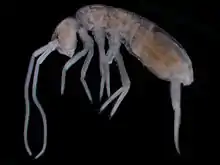Plutomurus ortobalaganensis
Plutomurus ortobalaganensis is the deepest terrestrial animal ever found on Earth, living at 1,980 metres (6,500 ft) below a cave entrance.[1] [2] It is a species of springtail (arthropods) endemic to the Krubera-Voronja cave system in Georgia. It was discovered in the CAVEX Team expedition of 2010.[3] It feeds on a few fungi and decomposing organic matter in the caves. [4]
| Plutomurus ortobalaganensis | |
|---|---|
 | |
| Scientific classification | |
| Kingdom: | Animalia |
| Phylum: | Arthropoda |
| Class: | Entognatha (?) |
| Family: | Tomoceridae |
| Genus: | Plutomurus |
| Species: | P. ortobalaganensis |
| Binomial name | |
| Plutomurus ortobalaganensis Jordana & Baquero, 2012 | |
Anatomy
It has a long antennae and is eyeless, it has a grayish body and has darker spots covering it. [4]
References
- Jordana, R.; Baquero, E.; Reboleira, S.; Sendra, A. (2012), "Reviews of the genera Schaefferia Absolon, 1900, Deuteraphorura Absolon, 1901, Plutomurus Yosii, 1956 and the Anurida Laboulbène, 1865 species group without eyes, with the description of four new species of cave springtails (Collembola) from Krubera-Voronya cave, Arabika Massif, Abkhazia", Terrestrial Arthropod Reviews, Netherlands, 5: 35–85, doi:10.1163/187498312x622430, hdl:10171/27607
- Sendra, A.; Reboleira, A. S. P. S. (2012), "The world's deepest subterranean community – Krubera–Voronja Cave (Western Caucasus)", International Journal of Speleology, USA, 42 (2): 221–230, doi:10.5038/1827-806x.41.2.9
- "CAVEX Team".
- "Live Science: The Most Interesting Articles, Mysteries & Discoveries". livescience.com. Retrieved 2020-12-27.
This article is issued from Wikipedia. The text is licensed under Creative Commons - Attribution - Sharealike. Additional terms may apply for the media files.